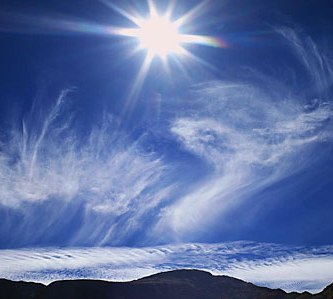|
Many weather-related myths surround Alaska's climate. One of the most common is that summer temperatures in Alaska are cool. In fact, like much of the United States, Alaska has four seasons and weather records at both ends of the thermometer. Alaska's summers are warm with highs that can reach into the 90°s. Ft. Yukon holds the all-time record with a sizzling 100°F temperature recorded in 1915. Many believe that the far northern part of Alaska would be the coldest. Actually, the record for Alaska (and the entire U.S. for that matter) was set in 1971 at Prospect Creek in the northern interior: a bone-chilling -80°F! When compared to high readings near 90°, Alaska's temperature range is an astonishing 170°.
Alaska's wide range of climates can be divided into six major zones. The southeast, which includes Juneau and the southeast panhandle, experiences mild winters and cool rainy summers, similar to a cooler version of Seattle. On an annual basis, this is both the wettest and warmest part of Alaska with milder temperatures in the winter and high precipitation throughout the year. This is also the only region in Alaska in which the average daytime high temperature is above freezing during the winter months.
The climate in south central Alaska, with Anchorage as a typical city, is mild by Alaskan standards. This is due in large part to its proximity to the coast. While it does not get nearly as much rain as the southeast of Alaska, it does get more snow, although days tend to be clearer here. It is a subarctic climate due to its short, cool summers. Summer temperatures can reach into the high 70s. Low humidity also contributes to Anchorage's comfortable climate. There are frequent strong southeast winds, known as the Knik wind, in the vicinity of Palmer, especially in the winter months.
The climate of Western Alaska is determined largely by the Bering Sea and the Gulf of Alaska. It is a subarctic oceanic climate in the southwest and a continental subarctic climate farther north. The temperature is somewhat moderate considering how far north the area is. This area has a tremendous amount of variety, especially when considering precipitation. The northern side of the Seward Peninsula is technically a desert with less than 10 inches (254 mm) of precipitation annually, while some locations between Dillingham and Bethel average around 100 inches (2,540 mm) of precipitation. Shielded by mountains, the region around Cook Inlet has longer colder winters and shorter warmer summers than anywhere around the Gulf.
The Aleutian Islands have year round stormy blistery weather. Expect lots of wind and rain when visiting the islands.
The coldest winter temperatures are found in Alaska's interior. The climate of the interior of Alaska is best described as extreme and is the best example of a true subarctic climate. Some of the hottest and coldest temperatures in Alaska occur around the area near Fairbanks Temperatures in Interior Alaska usually get higher than in Anchorage or other coastal areas. Fairbanks' average high is 70 degrees in June, 72 degrees in July and 66 degrees in August. In the winter, the temperature can fall below −60 °F (−51.1 °C).
Aortic winters are not as cold those in the interior, but snow can linger until July. The climate in the extreme north of Alaska is what would be expected for an area north of the Arctic Circle. It is an Arctic climate with long, very cold winters and short, cool summers. Even in July, the average low temperature is barely above freezing in Barrow, at 34 °F (1.1 °C).
Whenever and wherever you travel in "The Great Land," clothing is always a primary consideration. Emphasis should be based on comfort because the dress code is informal and casual. A layered technique is extremely good here.
Alaska is called the land of the midnight sun. A common notion about Alaska is that the whole state goes dark in the winter and has endless sunlight in the summer. That's not quite the case. Barrow, at the very top of the state, has a two-month winter period in which the sun doesn't rise. But that's the extreme, and winter's long nights get shorter the farther south you go. South of the Arctic Circle, every place has sunlight at least part of the day. In the summer, all of Arctic Alaska gets 24-hour sunlight for at least one day at the solstice. Barrow has continuous daylight for 85 days. South of the circle, every town has a night every day, even if it's quite brief. Long dawns and dusks can make the day appear longer than it actually is. Even as far south as Anchorage, it's possible to read a newspaper outdoors at 2 a.m. -- two hours after sunset -- in the days around the summer solstice. This summer, solstice occurs at 3:28 a.m. Alaska Daylight Time on June 21. The winter solstice occurs at 2:38 p.m. Alaska Standard Time on Dec. 21.
|





